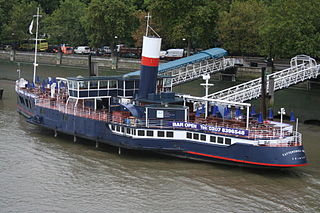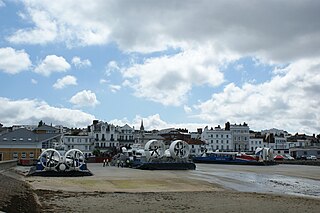
PS Waverley is the last seagoing passenger-carrying paddle steamer in the world. Built in 1946, she sailed from Craigendoran on the Firth of Clyde to Arrochar on Loch Long until 1973. Bought by the Paddle Steamer Preservation Society (PSPS), she has been restored to her 1947 appearance and now operates passenger excursions around the British coast.

PS Kingswear Castle is a steamship. She is a coal-fired river paddle steamer, dating from 1924 with engines from 1904. After running summer excursions on the River Medway and the Thames for many years she returned to the River Dart in Devon in December 2012 to run excursions from 2013 onwards on the river she was built on and for. Kingswear Castle is listed as part of the National Historic Fleet of ships of "Pre-eminent National Significance".

PS Tattershall Castle is a floating pub and restaurant moored on the River Thames at Victoria Embankment. It was a passenger ferry across the Humber estuary from 1934 to 1973, before being towed to London in 1976.

PS Ryde is a paddle steamer that was commissioned and run by Southern Railway as a passenger ferry between mainland England and the Isle of Wight from 1937 to 1969, with an interlude during the Second World War where she served as a minesweeper and then an anti-aircraft ship, seeing action at D-Day. After many years abandoned on moorings at Island Harbour Marina on the River Medina, she was purchased by the PS Ryde Trust in late 2018, with the intention of raising money for her restoration. That project was abandoned in January 2019.

There are currently three different ferry companies that operate vessels carrying passengers and, on certain routes, vehicles across the Solent, the stretch of sea that separates the Isle of Wight from mainland England. These are Wightlink, Red Funnel and Hovertravel.
Duchess of Norfolk was a 381 GRT paddle steamer built in 1911 for the London, Brighton and South Coast Railway and London and South Western Railway, who operated a joint service to the Isle of Wight. She was requisitioned by the Royal Navy for use as minesweeper HMS Duchess of Norfolk during the First World War, returning to her owners after the war ended. She passed to the Southern Railway on 1 January 1923.

TS King Edward was an excursion steamer built at Dumbarton for service down the River Clyde to the Firth of Clyde and associated sea lochs on the west coast of Scotland, as far as Campbeltown. The first commercial vessel to be driven by steam turbines, King Edward was remarkably successful for a prototype, serving as a Clyde steamer for half a century from 1901 until 1951, interrupted only by service in the two world wars. The success of the vessel quickly led to the adoption of turbine propulsion for all manner of merchant vessels, from channel ferries and coastal steamers to transatlantic liners.
PS/TSS Edith was a paddle steamer cargo vessel operated by the London and North Western Railway from 1870 to 1912.

PS Jeanie Deans was a Clyde paddle steamer, built in 1931 for the London and North Eastern Railway. She was a popular boat, providing summer cruises from Craigendoran until 1964.

This article describes the shipping services of the London and South Western Railway and the vessels employed.

PS Rouen was a passenger vessel built for the London, Brighton and South Coast Railway in 1888.

P & A Campbell was a shipping company based in Bristol which operated steamship services in the Bristol Channel between 1893 and 1979.
PS Adelaide was a passenger vessel built for the Great Eastern Railway in 1880.
PS Lady Tyler was a passenger vessel built for the Great Eastern Railway in 1880.
PS Norfolk was a passenger vessel built for the Great Eastern Railway in 1900.
PS Duchess of Edinburgh was a passenger vessel built for the London and South Western Railway and London, Brighton and South Coast Railway in 1884.
PS Duchess of Kent was a passenger vessel built for the London and South Western Railway and London, Brighton and South Coast Railway in 1897.

PS Whippingham was a passenger paddle steamer built for the Southern Railway in 1930 for the ferry route to the Isle of Wight. After distinguished war service, she returned to ferry work until she was scrapped in 1963.
PS Waverley was a Clyde-built paddle steamer that carried passengers on the Clyde between 1899 and 1939. She was requisitioned by the Admiralty to serve as a minesweeper during World War I and again in World War II, and was sunk while participating in the Dunkirk evacuation in 1940. The current PS Waverley, launched in 1946, was built as a replacement for this vessel.
Several vessels have been named Duchess of Buccleugh or Duchess of Buccleuch for one or another Duchess of Buccleuch:











